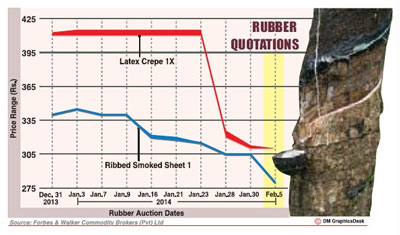06 Feb 2014 - {{hitsCtrl.values.hits}}
 Sri Lanka’s rubber prices have seen a considerable decline since the beginning of the new year, an analysis of the Colombo rubber auction prices by Mirror Business showed.
Sri Lanka’s rubber prices have seen a considerable decline since the beginning of the new year, an analysis of the Colombo rubber auction prices by Mirror Business showed. However, the auction prices throughout January 2014 for both Latex Crepe and RSS had been on the decline with the average price at the January 30, 2014 auction for Latex Crepe being within the range of Rs.247-310 and RSS 1 and 3 at Rs.275 and Rs.305, respectively, while RSS 2, 4 and 5 went unquoted.
However, the auction prices throughout January 2014 for both Latex Crepe and RSS had been on the decline with the average price at the January 30, 2014 auction for Latex Crepe being within the range of Rs.247-310 and RSS 1 and 3 at Rs.275 and Rs.305, respectively, while RSS 2, 4 and 5 went unquoted.
26 Dec 2024 24 minute ago
26 Dec 2024 1 hours ago
26 Dec 2024 2 hours ago
26 Dec 2024 4 hours ago
26 Dec 2024 5 hours ago